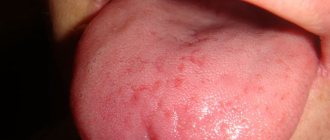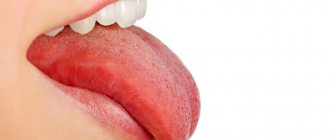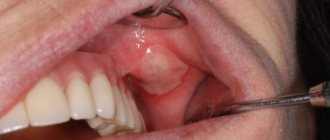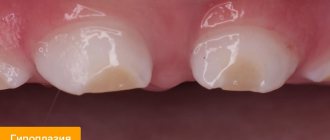Causes of the problem
A red spot on the tongue can be a manifestation of a variety of pathologies, for example:
- Vitamin deficiency
Redness of the tongue is caused by a deficiency of B vitamins and niacin.
- Allergy
Response to food, drinks, drugs
- The burn is
not only thermal, but also chemical. The Internet is full of different, sometimes strange, advice. Experimenting on yourself can have sad consequences.
- Hormonal imbalance
Red spots on the tongue often appear in women during pregnancy and menopause.
- Infections of various etiologies
Bacteria and viruses provoke inflammatory processes, one of the symptoms of which is discoloration.
Red spots on the tongue are not yet a diagnosis. A doctor needs to conduct an examination to determine the exact cause.
Redness of the tongue may indicate various diseases.
Types of “spotty” rashes
The spots that appear on the surface of the tongue can have a wide variety of colors: from deep red to light pink, white and even yellow. The affected areas may not be visible on the surface or may slightly protrude above healthy tissue. Such neoplasms are also distinguished by localization: in some cases, the spots completely cover the organ, in others they are concentrated on the side, at the tip, closer to the larynx or even under the tongue. All these characteristics must be taken into account by the doctor and help him make the correct diagnosis.
Why do red spots appear on the tongue?
As for the condition of the epithelium, depending on the pathology present, the surface of the organ can be smooth or slightly rough, with clearly enlarged filiform papillae. Sometimes a person notices one large spot, and sometimes many of them appear at once; they can be scattered all over the back or concentrated in small clusters. Similar problems can appear in both a child and an adult, however, there are certain diseases that occur mainly in children, for example, Kawasaki disease - in this case, the pathology is usually diagnosed in children under 5 years of age1.
Another important criterion for assessing neoplasms is the intensity of their color. So, for example, the same red color can be saturated, light or very pale. But the whitish areas have a grayish or yellowish tint. Such a wide variety of characteristics and probable causes of the problem makes diagnosis very difficult, so if you have suspicious symptoms, you should immediately go to a specialist.
Diagnosis
It is difficult to independently distinguish relatively harmless manifestations of diseases in the form of red spots from serious disorders. Any rash on the tongue already indicates systemic problems, but some of them indicate serious cases.
Erythroplakia requires immediate surgical intervention. Therefore, it is better not to take the position “it will go away on its own,” but to consult a doctor.
Since spots on the tongue are a symptom of disease, examination is usually aimed at identifying the causes. Laboratory tests, flora tests, histology and medical history allow us to make the correct diagnosis and prescribe appropriate treatment.
Treatment Basics
If an adult has a swollen tongue, the surface is covered with plaque, or has severe hypothermia, you should consult a dentist. Even in the absence of neoplasms in the oral cavity in the form of papules, ulcers or erosions, a specialist will be able to determine the development of the inflammatory process. With timely treatment, the risk of pathology becoming chronic is minimal.
Treatment of stomatitis on the tongue in adults is carried out exclusively conservatively. Depending on the causes of the disease and the clinical picture, the doctor will determine a treatment regimen and prescribe effective drugs of systemic and local action.
The dentist’s task is not only to eliminate symptoms and inflammation, but also to identify the cause. If the provoking factor has a constant impact, then stomatitis under the tongue will constantly recur.
Treatment of stomatitis on the tongue in adults begins with the relief of concomitant diseases - the root causes.
Online consultation with a doctor if you are concerned about symptoms
If you are concerned about symptoms such as spots on the tongue, accompanied by burning, tingling, pain, then it is best to undergo an examination and consultation with a dentist. Because these may be signs of a more serious disease that should not be neglected, otherwise inaction will lead to the need for longer-term and more expensive treatment. Red spots on the surface of the tongue may indicate a fungal, viral, or venereal infection. It is often difficult to determine on your own what it is: glossitis, stomatitis, Kawasaki disease or something else. A specialist will help you understand the signs of the disease and etiology online. He will give professional recommendations, suggest treatment options and further actions.
Causes of pimples on the tongue
The main causes of rashes:
- Traumatic injuries, burns. It is not uncommon for the tip or side surface of the tongue to be damaged by cutlery, excessively hot food, or one’s own teeth.
- Weakened immunity. When pimples appear on the tongue closer to the throat, at its base or near the frenulum, this may indicate reduced immunity. A variety of pimples and bumps are localized here: condylomas and warts, candidal bumps.
- Development of benign and malignant tumors.
- Poor nutrition, bad habits. If you violate the rules of nutrition, excessive consumption of spicy, hot, rough foods, an irritating and traumatic effect on the mucous membrane occurs, which provokes the appearance of pimples. Excessive smoking and alcoholic libations also cause diseases of the mucous membranes in adults.
- The causes of lumps at the end and root of the tongue may be allergic. Allergic disease manifests itself not only on the skin, but also on mucous membranes.
Large bumps located close to the pharynx make it difficult to swallow food and can lead to breathing blockage.
- If pimples appear on the tongue closer to the larynx, they could be caused by various diseases of a chronic, viral and infectious nature.
- Neglect of hygiene rules. Eating unwashed foods and irregular oral hygiene not only in children, but also in adults, causes irritation of the mucous membrane and, as a result, the appearance of inflamed pimples.
Disease prevention
Dental measures include:
- Regular thorough oral care.
A properly selected toothbrush, constant flossing, and rinsing your mouth after eating will help avoid inflammatory processes.
- Use a toothpaste that suits the purpose at this stage. You cannot use whitening or medicinal pastes constantly, only in courses.
General preventive measures:
- Healthy lifestyle
- To give up smoking
- Regular medical examinations
Associated symptoms
This symptom manifests itself in different ways. The tip of the tongue often burns, but sometimes the entire tongue or just the base burns. Often, with a burning sensation in the mouth, other accompanying symptoms are also noted. These include sore throat, dry mouth, difficulty swallowing, the appearance of white spots on the tongue, and others. The patient may also experience tingling, tingling, or rawness in the mouth. The nature of pain can be acute or chronic. If a symptom bothers you irregularly, then it is important to understand under what circumstances it develops. For example, if your tongue begins to burn whenever you eat pineapples, mangoes or other allergenic foods, then the cause is most likely food.
Expert opinion
Roman Borisovich Alekperov
orthopedic dentist
Experience: 24 years
Most often, red spots on the tongue are not accompanied by pain. A slight burning sensation or no symptoms at all creates a dangerous feeling that the problem will go away on its own. This can worsen the condition and cause serious consequences. If you have red spots on your tongue, consult a doctor. It is better to quickly take measures recommended by professionals than to spend a long time on treatment later.
Changes that should alert parents
In addition to changes in the color of the taste organ, parents should be wary of other accompanying symptoms, including:
- swelling, against which the imprints of teeth can be seen;
- insufficient moisture or obvious dryness of the surface of the tongue;
- enlarged papillae, especially pronounced in the root part;
- formation of persistent plaque on the surface of the tongue;
- burning sensation and impaired taste perception;
- the appearance of a specific odor from the mouth.
Parents can notice these changes during a visual inspection, which is best done in the morning in natural light. If the situation continues for a long time, the plaque thickens and the color of the tongue does not return to normal, there is every reason to consult a doctor to find out the reasons and identify hidden pathology.
Where to contact
Any dentist will be able to help with advice, but it is still better to contact multidisciplinary clinics. The larger the clinic, the more patients, which means the doctors’ experience is much wider. In addition, high-quality specialists are rarely seen in modest dentistry on the outskirts of the city; they mostly work in large centers. Another reason to contact a multidisciplinary center is that they pay great attention to improving the qualifications of doctors, including in therapeutic dentistry.
The table shows contacts of 5 clinics where you will be advised about red spots on the tongue.
| Dental center | Clinic address | Working hours |
| ROOT | Moscow, st. Rustaveli, 14 building 9 8 800 775–26–37 | 10:00-22:00 seven days a week |
| Your smile.rf | Moscow, Palikha street, 10, building 9 8 | 9:00-21:00 seven days a week |
| Center Family Dentistry | Moscow, Orekhovy Boulevard, 59k2 8 | 9:00-21:00 seven days a week |
| Unident | Moscow, Bobrov lane, 4, building 1 8 | 9:00-21:00 seven days a week |
| CityDent | Moscow, st. Novocheremushkinskaya, 57 8 | 10:00-23:00 day off - Sunday |
What causes red spots to appear on the sky?
The appearance of red spots on the sky can have many causes. In some cases, spots are a minor concern, but in others they may be a sign of more serious conditions that may require further investigation. The most common possible causes are described below:
Aphthous stomatitis
Most people have suffered from canker sores at some point. This disease is accompanied by the appearance of ulcers, which most often form on the mucous membrane of the cheeks and lips, but can occur in different places, including the palate. The development of canker sores is usually caused by stress, consumption of certain foods, or other irritants. The ulcers usually appear as small red bumps, in the middle of which, over time, a small whitish sore appears. There are over-the-counter medications available on the market to treat this condition, and most ulcers heal within a week or 10 days.
Candidiasis
The disease is also known as thrush or oral candidiasis. It is caused by the growth of fungal microorganisms and is accompanied by the appearance of red growths and white spots in the oral cavity. Candidiasis is common among people with dentures and diabetes, and treatment often involves preventing fungal overgrowth in the first place. According to the ADA, in particularly severe cases, oral antifungals may also be used to combat the fungus. For more information about candidiasis, visit the Colgate Center for Dental and Oral Health pages.
Coxsackie viruses
Coxsackie viruses are the causative agents of a disease that affects the skin of the hands and feet, as well as the mucous membrane of the oral cavity; they can cause the formation of painful blisters and red spots on both the skin of the hands and feet and on the roof of the mouth. Most often, the disease caused by such viruses is observed in children under five years of age, but it can develop at any age. Treatments include over-the-counter medications to treat fever and relieve pain, as well as special medicated mouth rinses to relieve the discomfort caused by mouth ulcers.
In rare cases, mouth sores and lesions can be a sign of oral cancer, so it is important to have any affected areas that are painful, interfere with eating or drinking, or are not healing quickly, examined by a dentist.











